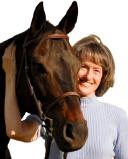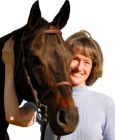Fear
Mastering Human Fear
How can you create and apply a toolbox for fear management?
Posted January 11, 2023 Reviewed by Davia Sills

Horseback riding helps us learn to manage fear during all sorts of activities. Horses can be scary for several reasons:
- They’re huge. The average horse weighs 1,200 pounds and stands over five feet tall at the shoulder, with the head and neck rising upward from there. One hoof can crush your entire foot.
- They have tremendous speed and agility. Horses are prey animals: Their brains and bodies are designed to escape by whirling and bolting in the blink of an eye.
- Horses and riders partake in extreme sports. Imagine galloping down to a brick wall you can’t even see over and staying on a horse while she flies over the top, standing on a half-inch of stirrup at 40 miles per hour in a race, tipping so far sideways around a barrel that your leg is plowing the dirt, or trail riding when a band of downhill mountain bikers round a blind curve and nearly knock your horse down.
All riders experience fear at some point. Fear is something we have to master in all areas of life unless we plan to sit on the couch from birth to death. For many people, it’s scary to initiate friendships, walk around on a roof, go to a job interview, or speak in public.
How to manage fear
One of the most effective means of mastering fear in any sport or human activity is to learn concrete physical actions for fear management ahead of time. These actions are placed in a mental toolbox that can be deployed when the mind becomes anxious. An easy example is counting. As a horse steps forward, riders learn to count those equine steps aloud (“one, two, three, four...”).
This simple count moves the rider’s attention gently away from fear and toward counting. It causes the horse, who is listening to the count, to move in a more rhythmic, consistent fashion. It distracts a tense horse and rider from other noises that might cause a startle response and lead to trouble.
Breathing in time with the horse’s steps is another action for the toolbox. It can be done without altering the rider’s normal respiratory timing. Some people inhale for every two steps the horse takes, then exhale for the next two steps. Others might inhale every three steps, let’s say, and exhale every four. Tailor breaths for yourself and for the particular type of anxiety you experience.
One of my favorite brain-based techniques for fear on horseback involves counting backward. For many people, counting “one, two, three, four” is too simple to generate mental distraction. These are people who can count aloud while thinking silently, “I’m about to die!”
I give them a starting number, like 100. They count back by threes, for example: “100, 97, 94, 91, 88…” Doing this in time with the horse’s steps provides an excellent degree of mental distraction from fear. You can adjust the difficulty of this mental exercise. It’s easier to count back by threes from 100 than from 3,782. It’s also easier to count backward by twos than by sevens. Choose the variation that best fits your needs.
Concrete physical actions work better than mental thoughts.
It’s easier to remember an embodied action when the stakes turn scary, and the physics of horseback riding is aided by certain embodied movements. The same is true for almost any sport or activity.
For example, a rider’s center of gravity is much higher than the horse’s. That means a small move from him can cause you to fly upward like a champagne cork, then land hard after a 15-foot fall from the sky. To avoid this—and keep hospital beds open—I remind riders to keep their heels weighted down hard when they’re scared. This lowers their center of gravity, so they’re less likely to fly upward or fall down when the horse makes a big move. But it also serves as a fear management tool that can be pulled out whenever riders get jittery. It’s something they can actually do to regain a sense of mental control.
Another physical action is to keep the upper body vertical. There’s a natural reaction to fear that causes riders to adopt a fetal position. The head and shoulders tip forward, eyes stare down at the dirt, the back rounds, and hands and knees move toward each other while muscles clench. Vertical body position is much safer and allows for proper breathing as well. But again, the critical point here is that sitting taller gives the rider a physical concentration point that alleviates fear.
You can tailor a toolbox for fear management to any sport or activity.
It doesn’t have to involve horses. Inside it, store well-practiced techniques like counting forward, breathing, and/or counting backward while you perform the action that scares you. Connect the physical action of your sport with the physical movements of your body, like I do with equine steps and human breaths. Add to fear management the physics of your activity: perhaps widespread arms, forward eyes, and bent knees to lower your center of gravity in ice skating, or your feet at shoulder width with hands relaxed and chest open while speaking in public. Practice these techniques ahead of time, not only as actions that improve your ability but also as actions that reduce your fear.
Just the act of learning specific physical actions and keeping them in our fear toolboxes is helpful. It means that when we are afraid, there are specific, concrete things we can do. This gives us a feeling of control over the situation, which soon morphs into mastery over fear. By contrast, telling someone, “Don’t be scared,” is laughably useless. Fill their toolbox instead!


